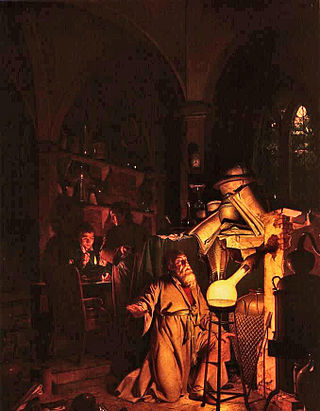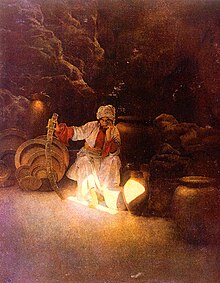
One Thousand and One Nights is a collection of Middle Eastern folktales compiled in the Arabic language during the Islamic Golden Age. It is often known in English as the Arabian Nights, from the first English-language edition, which rendered the title as The Arabian Nights' Entertainment.
The history of literature is the historical development of writings in prose or poetry that attempt to provide entertainment or education to the reader, as well as the development of the literary techniques used in the communication of these pieces. Not all writings constitute literature. Some recorded materials, such as compilations of data are not considered literature, and this article relates only to the evolution of the works defined above.
Arabic literature is the writing, both as prose and poetry, produced by writers in the Arabic language. The Arabic word used for literature is Adab, which comes from a meaning of etiquette, and which implies politeness, culture and enrichment.

Antarah ibn Shaddad al-Absi, ʿAntarah ibn Shaddād al-ʿAbsī; AD 525–608), also known as ʿAntar, was a pre-Islamic African-Arab knight and poet, famous for both his poetry and his adventurous life. His chief poem forms part of the Mu'allaqāt, the collection of seven "hanging odes" legendarily said to have been suspended in the Kaaba at Mecca. The account of his life forms the basis of a long and extravagant romance.

Antoine Galland was a French orientalist and archaeologist, most famous as the first European translator of One Thousand and One Nights, which he called Les mille et une nuits. His version of the tales appeared in twelve volumes between 1704 and 1717 and exerted a significant influence on subsequent European literature and attitudes to the Islamic world. Jorge Luis Borges has suggested that Romanticism began when his translation was first read.
Shaddād, also known as Shaddād bin ʽĀd, was believed to be the king of the lost Arabian city of Iram of the Pillars, an account of which is mentioned in Sura 89 of the Qur'an. Various sources suggest Shaddad was the son of 'Ad al-Miltat ibn Saksak ibn Wa'il ibn Himyar.

The literary genre of science fiction is diverse, and its exact definition remains a contested question among both scholars and devotees. This lack of consensus is reflected in debates about the genre's history, particularly over determining its exact origins. There are two broad camps of thought, one that identifies the genre's roots in early fantastical works such as the Sumerian Epic of Gilgamesh. A second approach argues that science fiction only became possible sometime between the 17th and early 19th centuries, following the scientific revolution and major discoveries in astronomy, physics, and mathematics.
Islamic literature is literature written by Muslim people, influenced by an Islamic cultural perspective, or literature that portrays Islam. It can be written in any language and portray any country or region. It includes many literary forms including adabs, a non-fiction form of Islamic advice literature, and various fictional literary genres.

The Banu Abs are an ancient Bedouin tribe that originated in central Arabia. They form a branch of the powerful and numerous Ghatafan tribes. They still inhabit the Arabian Peninsula and North Africa but have spread to many other regions of the world, as well. Their descendants today include the large Al Qubaisat tribe located in United Arab Emirates, Bani Rasheed tribe located in Saudi Arabia, Qatar, Yemen, Kuwait, United Arab Emirates, Oman, Sudan, Eritrea, and Jordan, and the Banu Rawaha located mostly in Oman and the UAE. They are known to be the second strongest tribe after The Prophet's Tribe. Parts of the Mahas tribe of the Butana region in Sudan are also linked by blood to the Banu Abs due to intermarriage between the Sudanese Rashaida tribe and the Mahas peoples. One of the earliest stories concerning this tribe was the famous classical love and war story of Antar and Abla.

Elements of the supernatural and the fantastic were an element of literature from its beginning, though the idea of a distinct genre, in the modern sense, is less than two centuries old.

Egyptian literature traces its beginnings to ancient Egypt and is some of the earliest known literature. Ancient Egyptians were the first to develop written literature, as inscriptions or in collections of papyrus, precursors to the modern book.
Theologus Autodidactus is an Arabic novel written by Ibn al-Nafis, originally titled The Treatise of Kāmil on the Prophet's Biography, and also known as Risālat Fādil ibn Nātiq. It was written sometime between 1268 and 1277 and is considered one of the earliest examples of a novel in Arabic literature. The novel contains elements of science fiction and is an early example of a coming-of-age tale and a desert island story. It was partly a response to the philosophical novel Hayy ibn Yaqdhan by Andalusi writer Ibn Tufail.
Genies or djinns are supernatural creatures from pre-Islamic and Islamic mythology. They are associated with shapeshifting, possession and madness. In later Western popular representation, they became associated with wish-granting and often live in magic lamps or bottles. They appear in One Thousand and One Nights and its adaptations, among other stories. The wish-granting djinns from One Thousand and One Nights, however, are the divs of Persian origin, not the Arabian djinns.
Sīrat Sayf ibn Dhī Yazan is a popular Arab romance dating to somewhere between the 15th and 16th century CE. A mixture of epic and pure fantasy, it is inspired by the life of Sayf ibn Dhī Yazan, a semi-legendary king of the pre-Islamic Himyarites who reigned in the 6th century CE. He is known for defending Himyar against invasions from the Aksumite Empire, with the help of the Persian Sassanid Empire.
Delhemma or Sirat Delhemma is a popular epic of the Arabic literature regarding the Arab–Byzantine wars of the Umayyad and early Abbasid periods.
This is a timeline of science fiction as a literary tradition. While the date of the start of science fiction is debated, this list includes a range of Ancient, Medieval, and Renaissance-era precursors and proto-science fiction as well, as long as these examples include typical science fiction themes and topoi such as travel to outer space and encounter with alien life-forms.
Al-Sīrah al-Nabawiyyah also known as Siraat-e Ibn Hisham is a prophetic biography of the Islamic prophet Muhammad, written by Ibn Hisham. According to Islamic tradition, the book is an edited recension of Ibn Isḥāq's Sīratu Rasūli l-Lāh 'The Life of God's Messenger'. The work of Ibn Hishām and al-Tabari work, along with fragments by several others, are the only surviving copies of the work traditionally attributed to Ibn Ishaq. Ibn Hishām and al-Tabarī share virtually the same material.
Sīra shaʿbiyya is a genre in Islamic literature consisting of long heroic narrative. The sīras are generally historical fictions, using historical settings, characters and events and focussing on military exploits. They are typical written in sajʿ interspersed with poetry. They are very long. In written form, they are 2000–6000 pages in printed editions. In oral performance, sessions may stretch out over a year.
Yasmine Seale is a British-Syrian writer and literary translator who works in English, Arabic, and French. Her translated works include The Annotated Arabian Nights: Tales from 1001 Nights and Aladdin: A New Translation. She is the first woman to translate the entirety of The Arabian Nights from French and Arabic into English. In 2020, she received the Queen Mary Wasafiri New Writing Prize for Poetry.








